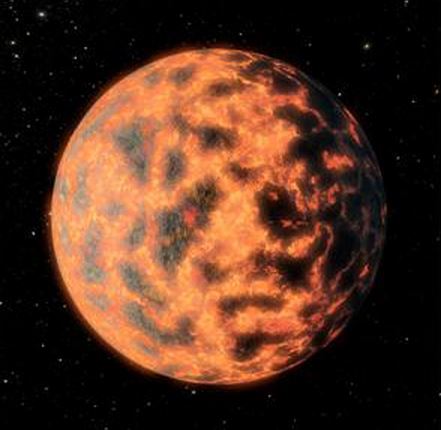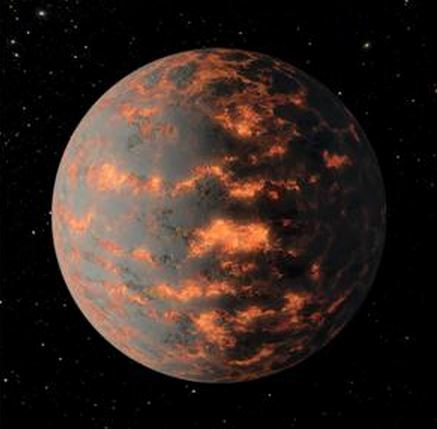Active volcanos have been detected 40 light years away on an ultra-hot super Earth by a team of scientists led by the University of Cambridge. The exoplanet, which in astronomical terms is classed as ‘nearby’, has steep temperature fluctuations likely due to huge amounts of volcanic activity.
It is nicknamed the Diamond Planet, because it is full of carbon (diamonds are made out of carbon). Officially called 55 Cancri e, this super Earth is the first rocky exoplanet so far discovered where atmospheric variability has been detected. An exoplanet is a planet that orbits a star outside our Solar System.
The scientists, who wrote about their discovery in the e-print repository arXiv, recorded a nearly threefold change in temperature on the super Earth over a two-year period.

Artist’s impression of 55 Cancri e, a super Earth, showing a hot partially-molten surface of the planet before volcanic activity. (Image: University of Cambridge)
Massive levels of volcanic activity
Dr. Nikku Madhusudhan, who works at the Institute of Astronomy, part of the University of Cambridge, and colleagues, stressed they are not 100% certain the atmospheric temperature fluctuations are caused by massive amounts of volcanic activity on the surface.
The authors say that being able to look at the atmosphere of a rocky exoplanet and study conditions on its surface is a major milestone in astronomy, and takes us nearer to identifying many habitable planets in the Universe.
The science team used NASA’s Spitzer Space Telescope, an infrared space observatory launched in 2003, to observe thermal emissions emanating from 55 Cancri e.
The super-Earth orbits a star which is very similar to our own Sun, forty light years from here in the Cancer constellation.
Extreme temperature fluctuations
According to the scientists’ findings, the temperatures on the hot ‘day’ side of 55 Cancri e fluctuate from 1,000 to 2,700 celsius.
Dr. Madhusudhan explained:
“This is the first time we’ve seen such drastic changes in light emitted from an exoplanet, which is particularly remarkable for a super Earth.”
“No signature of thermal emissions or surface activity has ever been detected for any other super Earth to date.”

The same planet (as the one in the picture above this one) after volcanic activity. (Image: University of Cambridge)
The wild changes in temperatures are probably due to massive plumes of gas and dust that sometimes cover the whole planet’s surface, which could be partially molten, according to their preliminary interpretations of the new data.
They believe the plumes are the result of intense volcanic activity, which is greater than what has been detected on ‘Io’ (one of Jupiter’s moons), the most active body in our Solar System.
Lead author, Dr. Brice-Olivier Demory, who works at the Cavendish Laboratory, University of Cambridge, said:
“We saw a 300 percent change in the signal coming from this planet, which is the first time we’ve seen such a huge level of variability in an exoplanet.”
“While we can’t be entirely sure, we think a likely explanation for this variability is large-scale surface activity, possibly volcanism, on the surface is spewing out massive volumes of gas and dust, which sometimes blanket the thermal emission from the planet so it is not seen from Earth.”
55 Cancri e is a tidally-locked planet
55 Cancri e is about twice the volume of earth and eight times the mass. It is extremely close to its star – completing one full orbit every 18 hours.
The super Earth is tidally locked, i.e. it does not rotate, one side (‘day’) is always facing the star while the other side (‘night’) is in permanent darkness.
The researchers said:
“Since it is the nearest super Earth whose atmosphere can be studied, 55 Cancri e is among the best candidates for detailed observations of surface and atmospheric conditions on rocky exoplanets.”
Most scientists have studied gas giants like Jupiter and Saturn, because they are easier to find, due to their massive size.
Recently, astronomers have managed to map the conditions on many of these gas giant planets. This is much harder with super Earths, which are relatively small, from one to ten times the mass of Earth. Jupiter’s mass is Earth’s times 317.
Initial observations suggest 55 Cancri e was composed of diamond, given its abundance of carbon. However, these latest results have challenged those earlier assumptions significantly and triggered a whole new set of questions.
Dr. Madhusudhan said:
“When we first identified this planet, the measurements supported a carbon-rich model. But now we’re finding that those measurements are changing in time. The planet could still be carbon rich, but now we’re not so sure – earlier studies of this planet have even suggested that it could be a water world.”
“The present variability is something we’ve never seen anywhere else, so there’s no robust conventional explanation. But that’s the fun in science – clues can come from unexpected quarters.”
“The present observations open a new chapter in our ability to study the conditions on rocky exoplanets using current and upcoming large telescopes.”
The paper was also co-authored by Professor Didier Queloz of the Cavendish Laboratory and Dr. Michaël Gillon of the Université of Liège in Belgium.
Reference: Brice-Olivier Demory, Didier Queloz, Michael Gillon, and Nikku Madhusudhan. “Variability in the super-Earth 55 Cnc e.” arXiv. Submitted 1st May, 2015. Cited as arXiv:1505.00269 [astro-ph.EP].
